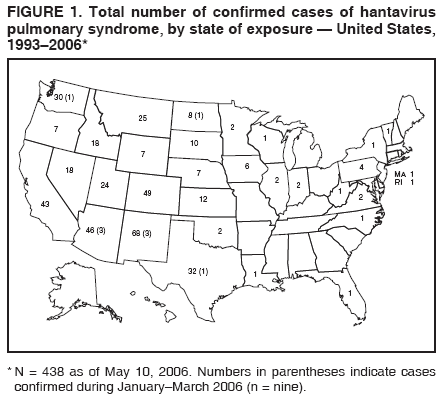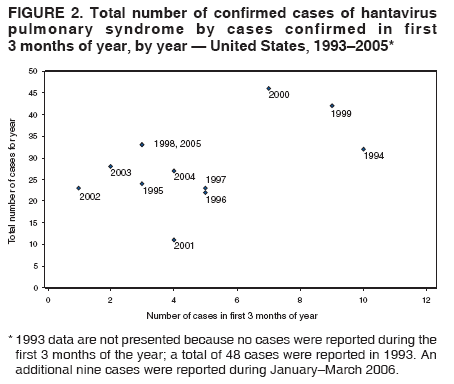 |
|
|
|
|
|
|
| ||||||||||
|
|
|
|
|
|
|
||||
| ||||||||||
|
|
|
|
|
Persons using assistive technology might not be able to fully access information in this file. For assistance, please send e-mail to: mmwrq@cdc.gov. Type 508 Accommodation and the title of the report in the subject line of e-mail. Hantavirus Pulmonary Syndrome --- Five States, 2006Hantavirus pulmonary syndrome (HPS) is a rodentborne viral disease characterized by severe pulmonary illness and a case-fatality ratio of 30%--40%. Sin Nombre virus causes the majority of HPS cases in the United States, and the deer mouse (Peromyscus maniculatus) is its predominant reservoir. This report describes an increase in human cases of HPS reported during January--March 2006 from Arizona, New Mexico, North Dakota, Texas, and Washington state. The findings emphasize the need for renewed attention to reducing the risk for hantavirus exposure. Human HPSHPS is characterized by a febrile illness (i.e., temperature >101.0ºF) associated with bilateral diffuse interstitial edema of the lungs developing within 72 hours of hospitalization in a previously healthy person; radiographically, the edema can resemble acute respiratory distress syndrome (1). Annually, the majority of HPS cases occur in spring and summer; however, the seasonality of HPS can vary by elevation, location, and biome, and cases have been identified throughout the winter and early spring (2). Since recognition of the disease in 1993, CDC has confirmed 438 cases of HPS* reported from 30 states among residents of 32 states (Figure 1); 35% (154) of these cases were fatal. During January--March 2006, a total of nine confirmed cases (based on onset date) of HPS were reported from Arizona, New Mexico, North Dakota, Texas, and Washington. Six of the nine cases were in Arizona and New Mexico. During 1994 and 1999, a similar number of HPS cases was confirmed nationally in the same 3-month period. Both years were characterized by environmental conditions (e.g., increased rainfall and vegetative biomass) during the preceding 1--2 years that promoted increased rodent populations. This, in turn, increased virus transmission in the rodent populations and increased exposure risk for humans (2--4). During 1994, 1999, and 2000, more than six cases were confirmed in the first 3 months of each year, and all had a high yearly total of HPS cases (Figure 2). Nine cases of HPS were identified in the first 3 months of 2006, suggesting that a greater risk for human hantavirus infection might exist this year. Reported by: D Engelthaler, C Levy, Arizona Dept of Health Svcs. P Ettestad, DVM, New Mexico Dept of Health. K Kruger, North Dakota Dept of Health. J Schuermann, Texas Dept of State Health Svcs. M Leslie, DVM, Washington Dept of Health. Special Pathogens Br, Div of Viral and Rickettsial Diseases, National Center for Zoonotic, Vector-Borne, and Enteric Diseases (proposed), CDC. Editorial Note:Hantavirus infection can occur after exposure to infectious virus in rodent saliva or excreta. HPS typically begins as headache, fever, and myalgia and is soon followed by pulmonary edema, which often leads to severe respiratory compromise; thrombocytopenia, presence of immunoblasts, and hemoconcentration are characteristic laboratory findings (1). Other than supportive care, no treatment exists for hantavirus infection. The probability of surviving HPS increases with early recognition, hospitalization, and aggressive pulmonary and hemodynamic support (5,6). All health-care providers are strongly encouraged to become familiar with the signs and symptoms of HPS (7) and to report suspected cases immediately to their state health departments. Since 1994, CDC has sponsored continuous monitoring of rodent populations at study sites in Arizona, Colorado, New Mexico, and Montana (8). Larger rodent populations and subsequent higher prevalence of hantavirus infection in rodent populations have been associated with higher risk for hantavirus exposure in human populations (2,9,10). Environmental conditions, including increased rainfall during 2005, likely contributed to increased rodent populations in certain areas of the Southwest. Some rodent monitoring sites have continued to have high rodent population densities or high levels of hantavirus infection during spring 2006, suggesting an increased risk for hantavirus infection among human populations in certain rural areas (J Mills, PhD, personal communication, May 2006). Public health education (especially among residents of rural areas of the western United States) regarding the importance of risk-reduction measures should be emphasized, especially in spring and summer, when the majority of previous HPS cases have been identified. Most persons with HPS are thought to have been infected in and around their homes; therefore, limiting opportunities for peridomestic exposure to rodents and their excreta is particularly important. CDC's Seal Up! Trap Up! Clean Up! campaign offers detailed information on preventing transmission of diseases from rodents and a comprehensive rodent-control website.† Measures to prevent HPS include 1) sealing up holes inside and outside the home to prevent entry by rodents, 2) trapping rodents around the home to help reduce the rodent population, 3) cleaning up potential rodent food sources and nesting sites, and 4) taking precautions when cleaning. CDC also provides detailed recommendations for HPS risk reduction (10). Additional information regarding HPS is available from local or state health departments; through the hantavirus hotline, 404-639-1510; on CDC's All About Hantaviruses website§; and by mail.¶ References
* As of May 10, 2006. † Available at http://www.cdc.gov/rodents. § Available at http://www.cdc.gov/hantavirus. ¶ Special Pathogens Branch, Division of Viral and Rickettsial Diseases, National Center for Infectious Diseases, Mailstop G-14, 1600 Clifton Road, N.E., Atlanta, GA 30333. Figure 1  Return to top. Figure 2  Return to top.
Disclaimer All MMWR HTML versions of articles are electronic conversions from ASCII text into HTML. This conversion may have resulted in character translation or format errors in the HTML version. Users should not rely on this HTML document, but are referred to the electronic PDF version and/or the original MMWR paper copy for the official text, figures, and tables. An original paper copy of this issue can be obtained from the Superintendent of Documents, U.S. Government Printing Office (GPO), Washington, DC 20402-9371; telephone: (202) 512-1800. Contact GPO for current prices. **Questions or messages regarding errors in formatting should be addressed to mmwrq@cdc.gov.Date last reviewed: 6/7/2006 |
|||||||||
|